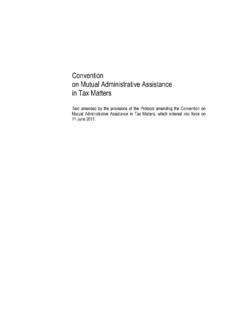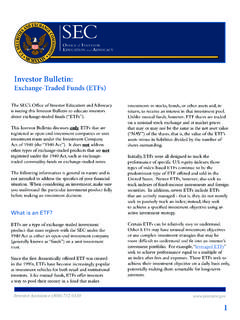Transcription of Mutual Aid Agreements: Types of Agreements - Homeland …
1 Backfill Emergency Memorandum of Management Understanding Fire Emergency Emergency Assistance Medical Services Compact Law Enforcement Mutual Aid Agreements : Types of Agreements PURPOSE. This Best Practice presents an overview of the various Types of Mutual aid Agreements and their respective purposes (or functions). SUMMARY. Mutual aid Agreements codify an understanding among two or more entities to provide support in a given context. Parties to Agreements can include two, three, or several response agencies, private organizations, hospitals, public utilities, governments, and virtually any type of organization that can bring resources to bear during an emergency. The needs of jurisdictions and organizations will vary greatly;. therefore, the set of Agreements each concludes will differ as well.
2 But at each tier of Mutual aid, jurisdictions should seek out strong, written Mutual aid Agreements to support response efforts in an emergency. DESCRIPTION. Purpose of Agreements Regardless of the specifics sought in a Mutual aid agreement , according to the Federal Emergency Management Agency (FEMA), the core reasons for drafting and concluding one are to: Coordinate planning. Agreements should facilitate and complement local and regional joint planning for large-scale incidents that will have far-reaching consequences. Multiply the response resources available to any one jurisdiction. The basic function of an agreement is to bring additional resources to bear when they are needed. Ensure timely arrival of aid. The quicker the response, the more lives that could be saved.
3 Agreements should streamline red tape and other procedural impediments so that resources are requested quickly and arrive in a timely manner. Arrange for specialized resources. Chemical, biological, radiological, nuclear, and explosives (CBRNE) terrorism will demand unique and often scarce resources. Mutual aid Agreements should seek to ensure the timely arrival of vital equipment and personnel. Minimize administrative conflict and litigation post-response. Liability, reimbursement, and other administrative matters should be addressed in a Mutual aid agreement . 1. Functional Areas of Agreements Because of the wide variety of organizations and resources involved in emergency responses, Mutual aid Agreements can serve a variety of functions. A needs assessment can help jurisdictions to determine potential resource shortfalls across the full range of functional areas.
4 Mutual aid Agreements can cost-effectively address these shortfalls by utilizing resources from other jurisdictions and departments. The following are some of the functional areas that Agreements can cover: Animals/Veterinary Services Hazardous Materials Administrative Support Law Enforcement Continuity of Service Logistical Support Colleges and Universities Mass Care Shelters Coroner/Mortuary Services Military Support Critical Incident Stress Management Medical Support Building Inspectors and Architects Private Sector Support Damage Assessment Public Information Officers Decontamination Public Works Emergency Managers Radio Communications Support Emergency Medical Services Schools Evacuation Transportation/Buses Financial Traffic and Access Control Fire-Fighting Search and Rescue Tiers of Mutual Aid Graph of Response At each phase of the response, Scale of from the first arriving units until Response Inter-state the end of the recovery phase.
5 Mutual Aid different Types of Mutual aid (EMAC). Agreements can serve the Incident Commander (IC). With strong Regional Mutual Aid Agreements at each level, lags or Automatic Statewide Mutual Aid gaps in response can be avoided (Local) Aid and operations can be as effective Mutual Aid as possible. The following is a Event Time description of each level of Mutual Begins aid: Automatic Aid Agreements . Units from neighboring jurisdictions are automatically dispatched to the scene as part of automatic aid Agreements . These interlocal Agreements are usually basic contracts or sometimes informal accords. The threshold for response is described in detail within the agreement . Mutual Aid. Mutual aid Agreements are between neighboring jurisdictions and involve a formal request for assistance.
6 Mutual aid is activated less often than automatic aid but covers a larger geographic area. 2. Regional Mutual Aid. Units from a regional Mutual aid Regional councils of governments in agreement can assist local Texas have developed regional Mutual units that have been on scene aid Agreements based on templates for an extended period of provided by the Texas Attorney time. Regional Mutual aid General's Office. The Alamo Area Agreements exist between Council of Governments, for example, multiple jurisdictions and are operates a regional Mutual aid often sponsored by a council agreement where jurisdictions join of governments (COG) or simply by passing an authorizing similar regional body. resolution. Statewide Mutual Aid. Statewide assistance California has a time-tested statewide significantly increases the Mutual aid agreement that mandates number of on-scene units.
7 Joint operational planning. The These Agreements , often California Master Mutual Aid agreement coordinated by the state ( emergency management all/CAMasterMutAid/$file/CaMasterMutA. agency, incorporate both ) is an opt-in contract that state assets and local assets connects planning, incident in an attempt to increase management, and Mutual aid into one preparedness statewide. overarching system. The National Emergency Management Association (NEMA) reports that only ten to 20 states have developed comprehensive statewide Mutual aid systems. Many states have less developed systems or systems that address only a portion of response such as fire or law enforcement. The best way to determine whether or not your state has an agreement is to contact the state emergency management agency, or EMA.
8 NEMA and the Department of Homeland Security ( ) have produced a model intra-state Mutual aid agreement . For more information, see the NEMA website ( ). Inter-State Agreements . Out of state assistance through the Emergency Management Assistance Compact (EMAC) supports the response effort towards the end of the first day and onward into the recovery phase. For more information, see the EMAC website ( ). Exceptions It is often the case that Agreements will not fit neatly into one of the categories listed above. Hybrid Agreements that include elements of different agreement Types are common with jurisdictions near state lines or response agencies in rural and frontier areas. Mutual aid Agreements are also possible with businesses, chambers of commerce, non-profit organizations, and military installations.
9 3. agreement Formats When determining proper agreement format, it is important to work with legal experts and the state EMA to determine what is legally appropriate. Some examples of agreement formats are included below for information purposes: Authorizing Resolution. An authorizing resolution represents Many states and regional governments will a jurisdiction's commitment to authorize Mutual aid through legislation, abide by specific regulations sometimes requiring a separate event outlined in a piece of legislation. agreement to spell out the details of each exchange. At the local level, memoranda of The resolution usually describes understanding or simple contracts are more important legal concepts and common because specifics can reasonably authorizes certain individuals to be dealt with in a single agreement .
10 Dispatch or receive Mutual aid under certain specified conditions. The details surrounding specific requests for Mutual aid are Opt-out Versus Opt-in determined at the time of the A state or county wishing to create a emergency. FEMA requirements Mutual aid system has the power to demand that accurate accounting mandate participation by way of legislation. An opt-out clause would state that all take place for both the request jurisdictions are party to the agreement and and receipt of Mutual aid if must opt out if they do not wish to federal reimbursement is desired. participate. Opt-out Agreements , when Some Mutual aid systems require possible, are very effective ways of even more detailed records, strengthening Mutual aid participation. often individual event Agreements that spell out On the other hand, legislation can be opt- equipment, cost, and other in , where each jurisdiction wishing to important event-specific details.






